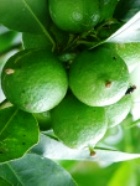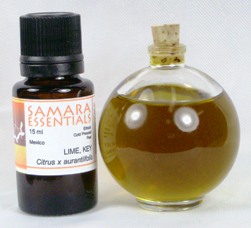
Plant Part: Peel
Extraction: Cold Pressed
Growing Practice: Ethical
Country of Origin: Mexico
Odor Type: CITRUS

Odor Characteristic: Cold pressed. This zesty-tart lime character has a somewhat pithy top note, but full-bodied lime character. Dryout is surprizingly sweet coumarin-like with a hint of oily-liminess.
Refractive Index: 1.48200 to 1.48500 @ 20.00 °C.
Specific Gravity: 0.87200 to 0.88100 @ 25.00 °C.
Appearance: pale green or olive green liquid
BioChemical Class: terpene, esters
BioChemicals: d-limonene (42-64%)
Bergapten (0.1-0.3%)
CAS No: 8008-26-2
About the Plant
The Key Lime (Citrus aurantifolia) of Family Rutaceae is a citrus with a spherical fruit 1-2 in. in diameter, yellow when ripe but often picked green. It is also known as Mexicon lime, West Indian lime, or Omani lime.C. aurantifolia grows to about 15 ft high, with mny thorns. The ovate leaves resemble orange leaves, Essentially scentless flowers (about 1 in. in diameter) and fruit can appear at any time of the year, but most abundant from May to September. C. aurantifolia is native to Southeast Asia, and probably moved through the Middle East to the Mediterranean, and then was carried to the Americas by Spanish explorers.
Perfumery:
Note: There has been great hype lately about "Key" lime in natural perfumery circles. Essentially, Key lime is C. aurantifolia, distributed throughout the tropical and semi-tropical Western hemisphere and SE Asia, N. Africa. The common name "Key lime" is associated with Key Lime Pie from the Florida Keys where it is the primary ingredient. It is not superior to (and indeed is the same as) any other aurantifolia in perfumery, with geo-production differences. The Persian Lime, C. latifolia is another species, larger than key limes and are those most likely found at your grocers. These turn yellow as they ripen and are then sometimes confused with lemons.![]()
The information provided on these pages is not a substitute for necessary medical care, nor intended as medical advice. Always keep aromatic extracts tightly closed and in a cool, dark place, out of reach of children. Never ingest aromatic extracts. Always dilute aromatic extracts when applying topically and avoid areas around eyes or mucous membranes. If redness or irritation occurs, stop using immediately and contact your health provider if necessary.![]()
all images and content copyright ©2000—2020 by suzumebachi design and samara botane





